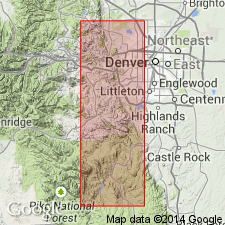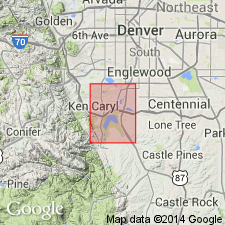
- Usage in publication:
-
- Glennon limestone member
- Modifications:
-
- Original reference
- Dominant lithology:
-
- Limestone
- AAPG geologic province:
-
- Denver basin
Summary:
Pg. 31, 36-40, fig. 8. Glennon limestone member of Lykins formation. Divided into number of distinct lithic units, several of which are persistent throughout the area. They are (ascending) hard brittle pinkish laminated limestone that ranges in thickness from 2 inches to 2.5 feet; gray to white fine-crystalline limestone with frequent vugs and laminated chert concretions; pink to gray irregularly laminated limestone; silty, impure laminated limestone; gray and pink limestone with distorted laminae; pink to gray regularly laminated limestone; and gray to pink coarsely crystalline vuggy imperfectly laminated limestone. Thickness at type locality 14 feet. Underlies Strain shale member (new); overlies Bergen shale member (new). Has been referred to commonly by various workers as "crinkled limestone." Age is Permian.
Type locality: in quarry on south side Turkey Creek, about 800 ft west of Glennon-Turkey Creek confluence, Golden-Morrison area, Jefferson Co., north-central CO. Named from Mount Glennon, btw. Bear Creek and Turkey Creek and southeast of town of Morrison, Jefferson Co., north-central CO.
Source: US geologic names lexicon (USGS Bull. 1200, p. 1525-1526).

- Usage in publication:
-
- Glennon limestone member
- Modifications:
-
- Mapped 1:24k (Littleton quad, Arapahoe, Douglas, and Jefferson Cos, CO)
- Dominant lithology:
-
- Limestone
- AAPG geologic province:
-
- Denver basin
Summary:
Is Permian? middle member of Lykins formation mapped in east-central Jefferson Co, CO (Denver basin). Crops out in valley between hogbacks of Lyons sandstone and Lytle and South Platte formations in southwestern portion of map area. Glennon is a resistant unit that forms small hogback, except where is obscured by debris from east flank of hogback of Lyons. Glennon as described by LeRoy (1946, CO Sch. Mines Quart., v.41, no. 2, p. 31) consists of 15 ft of grayish-orange-pink, moderate yellowish-brown, and yellowish-gray thin-bedded chert-bearing sandy limestone that is finely laminated, wavy, and intricately folded and faulted. Overlies map unit consisting of Harriman shale and Bergen shale members (undivided) (Permian?) of Lykins; underlies Strain shale member of Lykins (Permian? and Triassic?).
Source: GNU records (USGS DDS-6; Denver GNULEX).
For more information, please contact Nancy Stamm, Geologic Names Committee Secretary.
Asterisk (*) indicates published by U.S. Geological Survey authors.
"No current usage" (†) implies that a name has been abandoned or has fallen into disuse. Former usage and, if known, replacement name given in parentheses ( ).
Slash (/) indicates name conflicts with nomenclatural guidelines (CSN, 1933; ACSN, 1961, 1970; NACSN, 1983, 2005, 2021). May be explained within brackets ([ ]).

